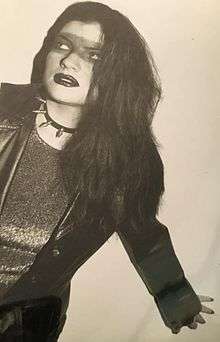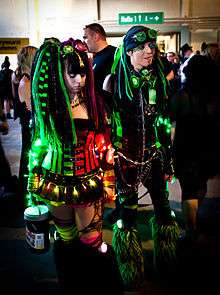Gothic fashion
Gothic fashion is a clothing style marked by dark, mysterious, antiquated and homogeneous features. It is worn by members of the Goth subculture. dress,[1] typical gothic fashion includes dyed black hair, dark lipstick and dark clothing.[1] Both male and female goths can wear dark eyeliner and dark nail polish - most often black. Male goths use cosmetics at a higher rate than other men. Styles are often borrowed from the punk fashion, Victorians and Elizabethans.[1] Goth fashion is sometimes confused with heavy metal fashion and emo fashion.

Characteristics

Cintra Wilson declares that "The origins of contemporary goth style are found in the Victorian cult of mourning."[2] Valerie Steele is an expert in the history of the style.[2]

Goth fashion can be recognized by its stark black clothing. Ted Polhemus described goth fashion as a "profusion of black velvets, lace, fishnets and leather tinged with scarlet or purple, accessorized with tightly laced corsets, gloves, precarious stilettos and silver jewelry depicting religious or occult themes".[3]
Nancy Kilpatrick's Goth Bible: A Compendium for the Darkly Inclined defines "poseur" for the goth scene as follows: "goth wannabes, usually young kids going through a goth phase who do not hold to goth sensibilities but want to be part of the goth crowd (...)". Kilpatrick contributor "Daoine O'" denigrates poseur goths as 'Batbabies' whose clothing is bought at [mall store] Hot Topic with their parents' money".[4]
Icons
One female role model is Theda Bara, the 1910s femme fatale known for her dark eyeshadow.[5][6] Siouxsie Sioux was particularly influential on the dress style of the Gothic rock scene; Paul Morley of NME described Siouxsie and the Banshees' 1980 gig at Futurama: "[Siouxsie was] modeling her newest outfit, the one that will influence how all the girls dress over the next few months. About half the girls at Leeds had used Sioux as a basis for their appearance, hair to ankle."[7] Robert Smith,[8] Musidora, Bela Lugosi,[9] Bettie Page, Vampira, Morticia Addams,[6] Nico, Rozz Williams, David Bowie,[1] Lux Interior,[1] Dave Vanian,[10] are also style icons. The 1980s established designers such as Drew Bernstein of Lip Service, while the 1990s saw a surge of US-based gothic fashion designers, many of whom continue to evolve the style through the current day. Style magazines such as Gothic Beauty have given repeat features to a select few gothic fashion designers who began their labels in the 1990s, such as Kambriel, Rose Mortem, and Tyler Ondine of Heavy Red.[11] Influential goth models include Wednesday Mourning, Adora BatBrat and Lady Amaranth.
Variations
Deathrock
Deathrock fashion, much like Goth music, is closely related to Goth fashion. The influences of the style come from a blend of glam rock, punk rock, gothic horror literature, and undead characters of classic horror films. The aesthetic was born from the early Los Angeles punk rock scene, and gained influences from fashion worn by patrons of the Batcave club in the UK as the two regional scenes had met. Many Deathrockers have a dark DIY punk approach on their attire. The common theme of the aesthetic is dominantly black clothing; Shirts featuring Deathrock bands or horror themes, torn fishnets as a shirt and/or hosiery, pale fleshtone or pale white foundation and powder makeup on the face, black or darkly colored eye makeup, combat boots or Doc Martens, and skirts, leggings, slim fit pants or shorts. Iconic hairstyles of this style are the "Deathhawk", mohawks or variants of mohawks, and spiky or teased hair. The horror punk and deathrock fashion section of the punk fashion article has more details.
Haute Goth
In 1977, Karl Lagerfeld hosted the Soirée Moratoire Noir party, specifying "tenue tragique noire absolument obligatoire" (black tragic dress absolutely required).[12] The event included elements associated with leatherman style.[12]
Goth fashion has a reciprocal relationship with the fashion world. In the later part of the first decade of the 21st century, designers such as Alexander McQueen,[2][13][14] Anna Sui,[15] Rick Owens,[14] Gareth Pugh, Ann Demeulemeester, Philipp Plein, Hedi Slimane, John Richmond, John Galliano,[2][13][14] Olivier Theyskens[14][16] and Yohji Yamamoto[14] brought elements of goth to runways.[2] This was described as "Haute Goth" by Cintra Wilson in the New York Times.[2] Thierry Mugler, Claude Montana, Jean Paul Gaultier and Christian Lacroix have also been associated with a gothic style.[13] In Spring 2004, Riccardo Tisci, Jean Paul Gaultier, Raf Simons and Stefano Pilati dressed their models as "glamorous ghouls dressed in form-fitting suits and coal-tinted cocktail dresses".[16] Swedish designer Helena Hörstedt and jewelry artist Hanna Hedman also practice a goth aesthetic.[17]
Gothic lolita
Gothic lolita, sometimes shortened to gosu rori (ゴスロリ) in Japanese, is a combination of Gothic and lolita fashions. The fashion originated in the late 1990s in Harajuku.[18]
Gothic lolita fashion is characterized by darker make-up and clothing.[19] Red lipstick and smokey or neatly defined eyes, created using black eyeliner, are typical styles, although as with all lolita sub-styles the look remains fairly natural.[20] Though Gothic make-up has been associated with a white-powdered face, this is usually considered poor taste within the (largely Japanese) lolita fashion scene.[21]
Brands which exemplify the Gothic lolita style include Atelier-Pierrot, Atelier Boz, Black Peace Now, H. Naoto Blood and Moi-même-Moitié. Author and TV Host La Carmina is a popular model of Gothic lolita fashion.
Aristocrat
Aristocrat is a type of Japanese street fashion, championed by the visual kei rock musician Mana with his fashion label Moi-même-Moitié,[22] and influenced by gothic and Neo-Victorian fashions. A typical outfit will combine elements of fetish wear with Victorian and sometimes steampunk fashions, including tight pants, velvet sportcoats, top hats, cravats, corsets, ankle length skirts, lace petticoats, and the frilly pirate shirts previously popularised by the New Romantics of the 1980s.
Cybergoth

The Cybergoth and rivethead subcultures emerged in America during the late 1990s, and combined classic gothic fashions such as leather duster coats, tripp pants or Demonia brand platform boots with the clothing worn by fans of industrial metal and rave music to create a dystopian, futuristic science fiction look.[23][24] Shaved heads, synthetic neon dreadlocks, camouflage, tight leather pants, chains, platform boots,[25] stretched body piercings, sleeve tattoos, goggles, corsets, PVC or leather skirts, and black trenchcoats decorated with metal studs are frequently seen on members of this subculture.[26]
Traditional Goth
Traditional Goth (or Trad Goth) is a term defining the aesthetic that reflects the classic and original aesthetics of Goth from the 1980s. The examples are from the attire worn by Bauhaus (band), Siouxsie Sioux, and The Cure. Dominantly black clothing, creepers, winklepickers, and backcombed, disheveled hair are common. Patrons of the Batcave club in the UK had an impact on the fashion with the attire they wore. This also has close relation to the Deathrock revival and fashion, as the 1980s Goth and Batcavers fashion influenced the aesthetic over the decades into the 2010s.
See also
- Body image
- Heavy metal fashion
- Fetish fashion
- New Gothic Art
- Punk fashion
- Gothic Subculture
Fashion accessories
- Choker
- Fishnet
- High-heeled shoes
- Pointed boots
- Thigh-high boots
References
- Footnotes
- Grunenberg 1997, p. 172
- Cintra Wilson, "You just can't kill it", New York Times, September 17, 2008. Access date: September 18, 2008.
- Polhemus 1994, p. 97
- Nancy Kilpatrick. Goth Bible: A Compendium for the Darkly Inclined. St. Martin's Griffin, 2004, p. 24
- Hannaham 1997, p. 93
- Steele & Park 2008, p. 26
- Reynolds, p. 425.
- Hannaham 1997, p. 113
- Steele & Park 2008, p. 18
- Steele & Park 2008, p. 38
- Holiday, Steven (12 December 2014). "Gothic Beauty". Portland, OR: Holiday Media. Retrieved 12 December 2014. Cite journal requires
|journal=(help) - Steele & Park 2008, p. 35
- Grunenberg 1997, p. 173
- Steele & Park 2008, p. 3
- Bolton, Andrew (2013). Anna Sui. New York: Chronicle Books. pp. 100–109. ISBN 1452128596 – via Google Books.
- La Ferla, Ruth: "Embrace the Darkness". New York Times, October 30, 2005.
- Johanna Lenander, "Swede and Sour: Scandinavian Goth," New York Times: T Magazine, March 27, 2009. Access date: March 29, 2009.
- Archived March 21, 2012, at the Wayback Machine
- Aoki, Deb. "Interview with the Editors of the Gothic and Lolita Bible". About.com. Retrieved 10 May 2010.
- Anonymous (2002). "Gothic Lolita Hair and Make Up". Gothic & Lolita Bible. Nuuberuguu. 4: 79.
- Anonymous (2002). "Neo Gothic Style". Gothic & Lolita Bible. Nuuberuguu. 4: 81.
- Anonymous (2002). "Artist Brands: Part 1, Mana x Moi-mene-Moitie". Gothic & Lolita Bible. Nuuberguu. 4: 23.
- Dead fashionable. Theage.com.au (13 September 2002).
- [Lauren M. E. Goodlad, Michael Bibby: Goth. Undead subculture, Duke University Press, 2007, ISBN 978-0-8223-3921-2, p. 47]
- "Gothic Fashion & clothing : The different variations of this style". Sew Guide. Retrieved 2020-01-02.
- [Baddeley, Gavin (2002). Goth Chic: A Connoisseur's Guide to Dark Culture. London: Plexus Publishing, p. 204.]
- Bibliography
- Grunenberg, Christoph (1997). "Unsolved Mysteries: Gothic Tales from Frankenstein to the Hair Eating Doll". Gothic: Transmutations of Horror in Late-Twentieth-Century Art. Boston: Mit Press. ISBN 978-0-262-57128-9. Retrieved 21 December 2011.CS1 maint: ref=harv (link)
- Hannaham, James (1997). "Bela Lugosi's Dead and I Don't Feel So Good Either: Goth and the Glorification of Suffering in Rock Music". Gothic: Transmutations of Horror in Late-Twentieth-Century Art. Boston: Mit Press. ISBN 978-0-262-57128-9. Retrieved 21 December 2011.CS1 maint: ref=harv (link)
- Polhemus, Ted (1994). Streetstyle: from sidewalk to catwalk. Thames and Hudson. ISBN 978-0-500-27794-2. Retrieved 21 December 2011.CS1 maint: ref=harv (link)
- Steele, Valerie; Park, Jennifer (21 October 2008). Gothic: Dark Glamour. Yale University Press and the Fashion Institute of Technology. Retrieved 21 December 2011.CS1 maint: ref=harv (link)
External links
![]()